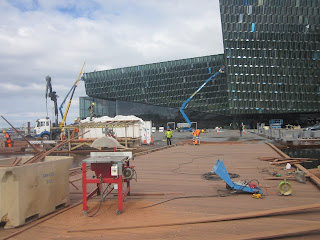We spent much of May traveling, including travels with family. One much anticipated part of the trip was a visit to Vopnafjörður, to visit my cousin who lives there, and to see the farm where my grandfather was born, that my great-grandparents farmed in the late nineteenth century. The farm is called Hraunfell (pronounced, roughly, kroyn-fetl), which means "lava hill". It has not been lived on or farmed since the late 1940s; my great-grandparents farmed it for just four years or so before leaving for North America.

The farm is along the highlands above the Sunnudals
á river (which flows into the Hofsá), and there is no road to get to it. So to get there, we drove to the last farm that is still inhabited, drove through their sheep pasture (they are friends of my cousin and we had permission!) and then hiked for about an hour up the river valley to the farm. The farm is marked on this map, near the center of the map in the lower left quadrant; it is very near Bustarfell, which is a well-preserved sod farmhouse, and now museum.
It is a beautiful place, in the river valley, with the Smjörfjöll (Butter mountains) on the other side of the river. Unfortunately, in our three days in Vopnafjörður, we did not see the mountains at all, as it was foggy, and then raining, sleeting, and then snowing the entire time we were there! So the day we hiked up to Hraunfell, it was cold and wet. But it was also beautiful.
On the way up, we encountered sheep and horses, of course, but also lots of birds including geese that were nesting. Here is one nest with several eggs, and below you can see where it was above the river. It was mid-May, so prime nesting season regardless of the weather.
The river is also beautiful, and there are falls and smaller tributaries flowing in all along the valley; we crossed many small streams on our way up.

About halfway up, my cousin's cell phone rang. And it turned out that it was a staff person from the university, looking for me, for my make-up examination that was to be given the next day. And here we need to digress to explain an administrative difference between the U.S. and Iceland. In the U.S., professors proctor their own exams, and if a student is sick or for some reason cannot make it to the final examination (or any examination) they must notify the professor to make whatever arrangements the professor is willing to make. In Iceland, final examinations are proctored by non-faculty, and the entire process is managed by the university. If a student is ill and cannot make it to an examination, the registrar's office is notified. The professor may never hear from the student, as in my case. So although I knew some students had missed the examination, I did not know that they had formally indicated to the university that they were ill, and wanted to take a make up exam. At any rate, modern technology being what it is, I was able to send a make up exam that evening, so that all ended well.
So the University of Iceland has now found me in probably the most remote place that I have been found by a university. But here is a another point of difference with the U.S.: it is highly unlikely that there would be cell phone service in a place like Hraunfell! So Iceland's good cell phone coverage made this little bit of incongruity possible.
So, after our brief interlude on the cell phone, we continued our hike, and eventually made it up in the sleet and rain to the farm. My great-grandparents would have lived in a sod structure; the stone foundation of it is still there and some of the sod, so you can see where it would have been. Later families added a wood frame, stone, and partially concrete house, next to the sod house, and there were also some remains of concrete in the barn though its foundation was primarily of stone and sod up until the 1940s.
It was wonderful to finally see this place. When it was inhabited, Hraunfell was the last farm along this valley, but there had been farms along our hiking path. So there would have been neighbors and perhaps it would not have felt as isolated as it seems now. Still, my great-grandparents, with their two young sons, felt that their future would be better in America when the left in 1893. They were among thousands who left from that area in the late 19th century; you can find out a great deal more about emigration from the northeast part of Iceland at the East Iceland Emigration Center website. And there has been an effort to provide information on how to hike to some of the highland farms in a nearby part of the Vopnafjörður area, which you can find
here.
I would love to go back up to Hraunfell on a summer day when you can see the mountains. But despite the weather, and the mid-hike phone call, I am glad we made it up to where my grandfather was born.
 |
| This is what remains of the barn. |
 |
| Here is a photo of the sod sheep enclosure fence. |
 |
This is the sod house, straight ahead,
with the newer house to the right. |
 |
| A closer view of the sod house. |
 |
What you see now, approaching the house;
the sod portion is back to the left and behind. |
 |
A view from the side with the sod house on the left
and the newer house behind it and to the right. |
 |
| A closer view of the stones and sod that were the walls. |
 |
| Here is a view from inside the newer house to the sod house behind. |



























